So, there I was; wondering what would
possess an educated fellow like myself to be standing in ankle-deep thick red mud at the bottom of a monster hole that I had dug. I knew that corundum collecting at the Propst Farm is usually a difficult and dirty proposition, but my current state of affairs was bordering on ridiculous. I had been digging and bailing muck for the better part of two hours and had not seen hide nor hair of corundum. I wondered if I would ever be able to completely evacuate the water that continued to stream in from all sides of the pit
bottom; if not, all my digging would have
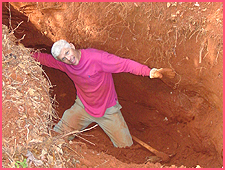 ended up being nothing more than brutal exercise. But with my wife Chrissy's help and encouragement, I continued to plug away, one shovel and bucket at a time. After all, I knew from many past experiences that you can't win if you don't play and the harder you play the more you will win. Finally, after moving what must have been 5 cubic yards of dirt and mud, the flow of water waned and I came upon a deeply-buried 12-inch wide loose quartz and weathered rock layer that I knew could contain corundum crystals. So, after 2-1/2 hours of digging, the pit was readied so that I could actually start looking for corundum.
ended up being nothing more than brutal exercise. But with my wife Chrissy's help and encouragement, I continued to plug away, one shovel and bucket at a time. After all, I knew from many past experiences that you can't win if you don't play and the harder you play the more you will win. Finally, after moving what must have been 5 cubic yards of dirt and mud, the flow of water waned and I came upon a deeply-buried 12-inch wide loose quartz and weathered rock layer that I knew could contain corundum crystals. So, after 2-1/2 hours of digging, the pit was readied so that I could actually start looking for corundum.
The Propst Farm in north Lincoln County, North Carolina has
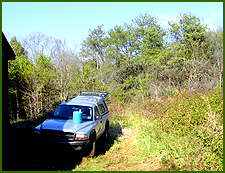 for decades been a source of large euhedral corundum crystals in various colors, including red, pink and deep blue. Corundum was first discovered by
for decades been a source of large euhedral corundum crystals in various colors, including red, pink and deep blue. Corundum was first discovered by
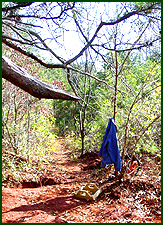 locals as loose crystals in their plowed fields and gardens. When the Propsts stopped farming the land, they began to allow rockhounds to access the fields and adjacent forest to collect for a small fee. Mrs. Propst, now a
widow, continues to allow rockhounding on her property, but she greatly frowns on having large groups show up all at once. It is my understanding that her dislike of large groups is mostly due to a certain unsavory former member of a rockhounding club who, while on a club trip there, threatened to kick her dog. Upon seeing this, she banned that person and all clubs from the site. However, it didn't take Mrs. Propst long to mellow so that she now allows individuals and small groups to access the property for a fee of $5 per person. By the way, the dog-hating knucklehead has been duly shunned by the other members of the club so that he no longer participates.
locals as loose crystals in their plowed fields and gardens. When the Propsts stopped farming the land, they began to allow rockhounds to access the fields and adjacent forest to collect for a small fee. Mrs. Propst, now a
widow, continues to allow rockhounding on her property, but she greatly frowns on having large groups show up all at once. It is my understanding that her dislike of large groups is mostly due to a certain unsavory former member of a rockhounding club who, while on a club trip there, threatened to kick her dog. Upon seeing this, she banned that person and all clubs from the site. However, it didn't take Mrs. Propst long to mellow so that she now allows individuals and small groups to access the property for a fee of $5 per person. By the way, the dog-hating knucklehead has been duly shunned by the other members of the club so that he no longer participates.
Our buddy, Harry Polly, had scheduled a field trip to the Propst Farm for Saturday, November 18th. Chrissy and I
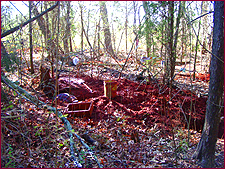 decided to make the 1-1/2 hour drive to join him and a handful of other members of the Catawba Valley Gem and Mineral Club. We had been to there a few
decided to make the 1-1/2 hour drive to join him and a handful of other members of the Catawba Valley Gem and Mineral Club. We had been to there a few
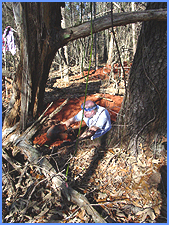 times before and had experienced just enough success to return optimistic. The Propst is the sort of site that will keep you honest because the digging is notoriously difficult and it is not unusual to drive away with absolutely nothing besides muddy clothes to show for a full day of hard work. Although I have enjoyed modest success the few times that I had been there, it usually takes me at least a couple years to cloud the memory of how brutal the digging is so that I will go back.
times before and had experienced just enough success to return optimistic. The Propst is the sort of site that will keep you honest because the digging is notoriously difficult and it is not unusual to drive away with absolutely nothing besides muddy clothes to show for a full day of hard work. Although I have enjoyed modest success the few times that I had been there, it usually takes me at least a couple years to cloud the memory of how brutal the digging is so that I will go back.
After after arriving that morning, I performed a brief recon of the area. For reasons that I will never be able to explain to others, my
 instincts told me to extend a pit that someone else had started near an area where I had found corundum crystals before. Harry and the rest of the crew
fanned out to dig, each in his own hole. Chrissy and I extended our pit to about 2 feet below the depth that the previous rockhound had left off and uncovered a layer of loose quartz and rock about 7 feet below grade. It is my
instincts told me to extend a pit that someone else had started near an area where I had found corundum crystals before. Harry and the rest of the crew
fanned out to dig, each in his own hole. Chrissy and I extended our pit to about 2 feet below the depth that the previous rockhound had left off and uncovered a layer of loose quartz and rock about 7 feet below grade. It is my
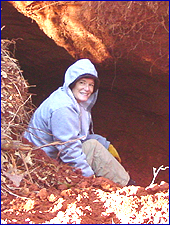 belief that the rocky layer composed mostly of angular quartz cobbles is a weathered quartz rich rock, such as a granite pegmatite, and all that remains after eons of oxidation and weathering are physically and chemically resistant minerals such as quartz and accessory corundum and zircon. According to my theory, the quartz-rich rock intruded Cambrian gneiss and schist that have, for the most part, completely weathered to iron-rich silt and clay. Some have speculated the quartz cobble with corundum layers are alluvial deposits, but the predominately angular nature of the quartz, corundum and accessory zircon belies this as one would expect greater rounding if alluvial. Moreover, the crisscrossing nature and up and down dipping of the relatively thin quartz rich layers are more indicative of fracture-filling quartz-rich rock that weathered in place than being deposited by stream action. But, with the above said, I must add that my theory about the genesis of the quartz cobble and corundum-rich layers is nothing more than educated arm waving on my part since I really haven't done the necessary geologic work to support my conclusion, but I did run it by Carl Merschat with the North Carolina Geological Survey and he agreed with me.
belief that the rocky layer composed mostly of angular quartz cobbles is a weathered quartz rich rock, such as a granite pegmatite, and all that remains after eons of oxidation and weathering are physically and chemically resistant minerals such as quartz and accessory corundum and zircon. According to my theory, the quartz-rich rock intruded Cambrian gneiss and schist that have, for the most part, completely weathered to iron-rich silt and clay. Some have speculated the quartz cobble with corundum layers are alluvial deposits, but the predominately angular nature of the quartz, corundum and accessory zircon belies this as one would expect greater rounding if alluvial. Moreover, the crisscrossing nature and up and down dipping of the relatively thin quartz rich layers are more indicative of fracture-filling quartz-rich rock that weathered in place than being deposited by stream action. But, with the above said, I must add that my theory about the genesis of the quartz cobble and corundum-rich layers is nothing more than educated arm waving on my part since I really haven't done the necessary geologic work to support my conclusion, but I did run it by Carl Merschat with the North Carolina Geological Survey and he agreed with me.
After several hours of digging and finding nothing, we decided to take a break for lunch. At least I knew that finding my sandwich was a guarantee. By then, the sun had warmed up what had been a chilly morning and the temperature was in the pleasant low 60's. While we were on break at our truck, Harry stopped by to tell us that he had dowsed the area with a couple metal rods. He was sorry to inform us that we may as well abandon our hole because his dowsing indicated that it was barren. "Tell me something that I don't know", I joked, but I wasn't quite ready to call it quits especially since there was no way that I was going to start a fresh hole that late in the game.
When we were done eating and chatting, we returned to our pit and continued to work the rocky layer. Within 5 minutes, we hit it big! In spite of Harry's dire forecast for success in our hole, I found a large perfectly formed pink sapphire crystal (both pictures below).